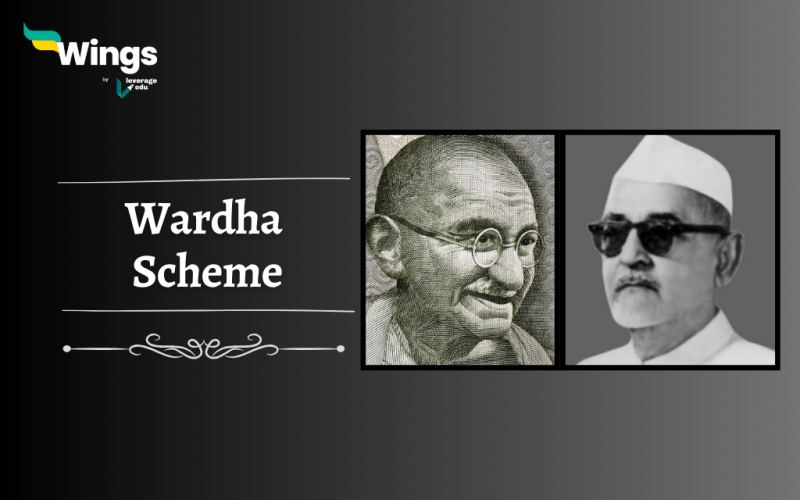The Wardha Scheme of Basic Education, 1937 also known as Nai Talim or Buniyadi Talim (Shiksha) was an initiative for rural development that has been instrumental in transforming the lives of people. Implemented by the government, this scheme focuses on improving infrastructure, education, healthcare and overall quality of life in rural areas. In this article, we will delve deeper into the history, features, and impact of the Wardha Scheme of basic education.
Table of Contents
History of the Wardha Scheme
The Wardha Scheme was launched by the INC with the aim of bridging the gap between urban and rural areas. The scheme draws inspiration from Mahatma Gandhi’s philosophy of village development and self-reliance.
- The Wardha Scheme came about due to Mahatma Gandhi’s realization of India’s ineffective education system.
- In 1931, at the Second Round Table Conference in London, Gandhi attributed the deterioration of education in India to British education policy.
- On 31st June 1937, Gandhi ji published an article in ‘Harijan’, his weekly magazine, discussing his views on the deterioration of the education system prevailing in India.
- He also proposed schemes to expand the education system to reach every nook and corner of Indian society.
In the 1937 elections, the Indian National Congress promised free and compulsory education in their manifestoes. After winning, INC decided to implement Gandhi’s Education scheme with some changes. They held the ‘All India National Educational Conference’ in Wardha to propose the scheme officially.
- Gandhi, along with other educationists, Congress leaders and Ministers, led the resolutions taken at the conference.
- In the Wardha Education Conference that was held on the 22nd and 23rd of October 1937, many resolutions were considered and adopted.
Three resolutions were passed to improve education in India. These resolutions included-
- Free and Compulsory education nationwide for seven years,
- Use of the mother tongue as the medium of instruction
- Focus on manual and productive work and not just Degrees and Examinations, thereby integrating subjects like Physical Environment, Crafts and Social Environment.
A committee was formed under Dr. Zakir Hussain’s leadership to implement these resolutions and develop a plan for basic education. The committee’s report was known as the Wardha Scheme of Basic Education or Nai Talim/Buniyadi Talim (Shiksha)/Buniyadi Shiksha. They submitted the National Basic Education Scheme report in March 1938.
Also Read: The First Round Table Conference, 1930-32
What was the objective of the Wardha Scheme?
The primary goal of the scheme is to improve the standard of living in rural communities and provide equal opportunities for growth and development. They also wished to build a nation of self-reliant people in India.
Also Read – What was the Hunter Commission?
What were the Features of the Wardha Scheme?
The main features of the Wardha Scheme of Basic Education (1937) are as follows –
- Education:
- Free and compulsory for 8 years (applicable for ages within 6-14)
- Open to all regardless of gender, culture or religion
- Mother tongue as the medium of instruction
- Self-paced learning with no exams.
- Flexible curriculum and free learning environment
- Integration of work and education:
- Combined with regional craftwork or productive work
- “Samanvaya” method to integrate education with local handicrafts
- “Work-centric” education to:
- Inculcate collective activity
- Build self-sufficient individuals
- Raise appreciation for labour
- Support emotional development

- Self-supporting system:
- Products created by students are sold to fund teacher salaries
- “Learn while you earn, earn while you learn” principle
- The State to initially cover other school expenses (furniture, books, tools, buildings)
- Later changed to partial self-support to prioritize education expansion by Dr. Zakir Hussain.
- Overall goals:
- Strengthen education foundation through mother tongue instruction
- Foster individual and collective development through work
- Expand education access to all regions of the country
Also Read – All India Women’s Conference: AIWC History and Initiatives
Scope and Limitations of Wardha Scheme
Some of the scopes of the Wardha Scheme are –
- Building self-sufficient and educated citizens across the nation (including all the cities & villages).
- A classless society, education through mother tongue and national integration.
- Flexible, adaptable curriculum, prioritizing practical experience & intellectual development.
- Self-funding education for addressing the unemployment and educational disparities.
Also Read – What was Wood’s Despatch?
Limitations of Wardha Scheme of Basic Education of 1937
- Coordination issues between official and unofficial stakeholders in implementing the scheme.
- Lack of proper teacher training and expertise was one of the hindrances.
- During the period of industrialization, there was difficulty in linking handicrafts to academic subjects.
- Some believe the overemphasis on crafts led to overshadowing core education.
- Another limitation was it had a negative psychological impact on the work-study model.
Just after implementing the scheme WWII started in 1939, and Indian National Congress ministers’ resignations hindered implementation. The Wardha Scheme emerged as the government’s commitment to rural development and inclusive growth. With its comprehensive approach towards infrastructure, education and sustainable practices.
| Development of Railways in India | August Declaration of 1917 |
| Indian Press Act of 1910 | Ahmedabad Mill Strike of 1918 |
| C.R. Formula of 1944 | Cabinet Mission of 1946 |
That’s all about the Wardha Scheme! If you want to read more articles like this, you can get Study notes on the Modern History of India here. Also, you can visit our general knowledge page on Indian History!
 One app for all your study abroad needs
One app for all your study abroad needs













